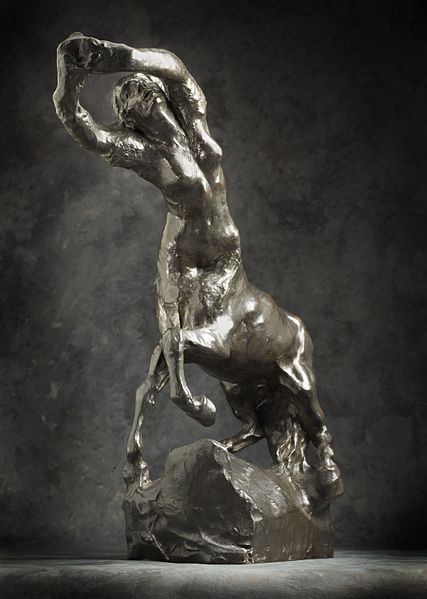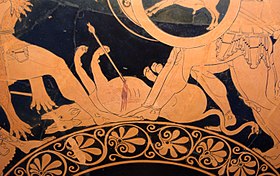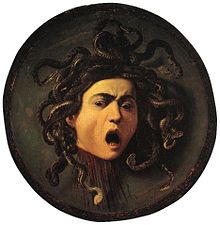Table of Contents
Creatures of myth
Work in progress…
Abraxas
Site search results
Atropos
Site search results
Basilisk
The Basilisk: (from the Greek βασιλίσκος basilískos, “little king;” Latin regulus) … said to have the power to cause death with a single glance.
From Wikipedia: Woodblock print of a basilisk from Ulisse Aldrovandi, Serpentum, et draconum historiae libri duo, 1640

Site search results
Buraq
Site search results
Centaur
Female centaur by Auguste Rodin (1840–1917)

To learn more about Rodin and explore his artwork, check out his page on Artsy.
Site search results
Cherubim, Cherub
| From Wikipedia | http://www.bible-history.com |
| <html><a href=“http://en.wikipedia.org/wiki/Cherub#mediaviewer/File:Tetramorph_meteora.jpg” target=“_blank”><img src=“http://upload.wikimedia.org/wikipedia/commons/8/89/Tetramorph_meteora.jpg”></a></html> | <html><a href=“http://www.bible-history.com/tabernacle/TAB4The_Cherubim.htm” target=“_blank”><img src=“http://www.bible-history.com/tabernacle/images/COVER2A.gif”></a></html> |
Site search results
Chimera
Site search results
Cerberus
Site search results
Cockatrice
Site search results
Echidna
Site search results
Erinyes
Site search results
Gorgon
Harpy
Site search results
Hippocamp
Jörmungandr
In Norse mythology Jörmungandr is the world serpent and the middle child of the giantess Angrboða and Loki.
From Wikipedia: “The children of Loki” (1920) by Willy Pogany

Site search results
Lamassu, shedu
From lamassu : is an Assyrian protective deity, often depicted with a bull or lion's body, eagle's wings, and human's head. In some writings, it is portrayed to represent a female deity. A less frequently used name is shedu (Sumerian: dalad; Akkadian, šēdu; Hebrew: שד) which refers to the male counterpart of a lamassu.
| <html><a href=“http://en.wikipedia.org/wiki/Lamassu#mediaviewer/File:Lammasu.jpg” target=“_blank”><img src=“http://upload.wikimedia.org/wikipedia/commons/thumb/d/d5/Lammasu.jpg/240px-Lammasu.jpg”></a></html> |
Medusa
Minotaur
Orthros or Orthrus
From Wikipedia: Orthrus is a two-headed dog who is a doublet (“brother”) of Cerberus, both whelped by the chthonic monsters Echidna and Typhon.

Site search results
Putto, Putti
Site search results
Seraphim, Seraph
From Wikipedia : Literally “burning ones”, the word seraph is normally a synonym for serpents when used in the Hebrew Bible. A seminal passage in the Book of Isaiah (Isaiah 6:1-8) used the term to describe fiery six-winged beings that fly around the Throne of God crying “holy, holy, holy”. This throne scene, with its triple invocation of holiness (a formula that came to be known as the Trisagion), profoundly influenced subsequent theology, literature and art. Its influence is frequently seen in works depicting angels, heaven and apotheosis. Seraphs are mentioned as celestial beings in an influential Hellenistic work, the Book of Enoch, and the Book of Revelation. Tradition places seraphs in the fifth rank of ten in the Jewish angelic hierarchy and the highest rank in the Christian angelic hierarchy.
Site search results
Scylla
Site search results
Site search results
Sphinx
The Sphinx - Body of a lion, human head.
| Taken from http://www.artrenewal.org Francois-Xavier Fabre (Francois Xavier Fabre) (1766-1837) Oedipus and the Sphinx Oil on canvas |
| <html><a href=“http://www.artrenewal.org/pages/artwork.php?artworkid=4203” target=“_blank”><img src=“http://www.artrenewal.org/artwork/645/645/4203/oedipus_and_the_sphinx-large.jpg” width=“500”></a></html> |
Site search results
Typhon
Typhon was traditionally identified with the Egyptian Set (Seth)
Site search results
Site search results
Site search results
Valkyrie
Site search results
